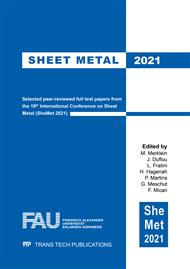p.242
p.250
p.258
p.269
p.277
p.285
p.294
p.303
p.309
The Frictional Force between Slug and Die in Shear Cutting after Material Separation
Abstract:
Frictional forces in sheet metal blanking are central in different aspects, e.g. in wear prediction, validation of simulation models or in so called slug pulling. The latter is a phenomenon where the slug is pulled out of the die by the punch after the sheet metal is separated. This leads to process disturbances reaching from a blocked belt feeder up to severe tool damage caused by the simultaneous cutting of the slug and the sheet metal strip. A sufficiently high frictional force between the slug and the die prevents this effect. Despite its importance, this force and its causes have not yet been investigated in detail. A method was developed in this paper to measure the frictional force between slug and die. A shear cutting tool with an integrated piezoelectric load cell and an inductive position sensor was used on a stamping press to cut sheet metal made of CuSn6 (R350, thickness 1 mm). The die clearance, the punch edge radii and the lubrication conditions were varied. A larger die clearance resulted in a lower frictional force while a larger punch edge radius increased it significantly. Lubrication reduced the frictional force, especially for small die clearances. Finally, the cause of the frictional force was investigated by identifying the relevant springback modes of the slugs. This was carried out by correlating the slugs' deflection, oversize, and clean cut height with the frictional force. Especially the slug oversize, i.e. the difference between the slug's diameter and the die's inner diameter, revealed a strong correlation. Calculations showed that the deformation in radial direction is the main cause of the frictional force between slug and die. It suggests that the slug oversize is a good measure for the magnitude of the frictional force.
Info:
Periodical:
Pages:
285-293
Citation:
Online since:
April 2021
Keywords:
Price:
Сopyright:
© 2021 Trans Tech Publications Ltd. All Rights Reserved
Share:
Citation:


